L18-部分限定词的区别 初中英语词性句法新讲课件(共19张PPT)
文档属性
| 名称 | L18-部分限定词的区别 初中英语词性句法新讲课件(共19张PPT) | 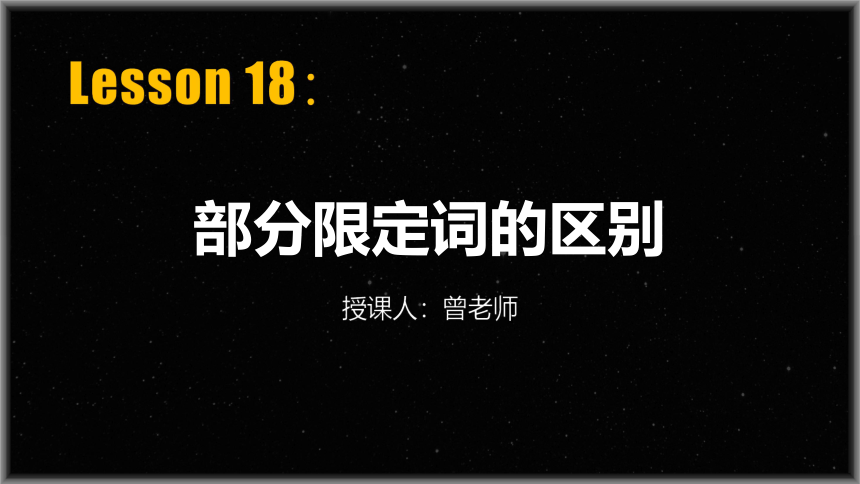 | |
| 格式 | ppt | ||
| 文件大小 | 1.1MB | ||
| 资源类型 | 试卷 | ||
| 版本资源 | 通用版 | ||
| 科目 | 英语 | ||
| 更新时间 | 2022-04-10 22:24:18 | ||
图片预览

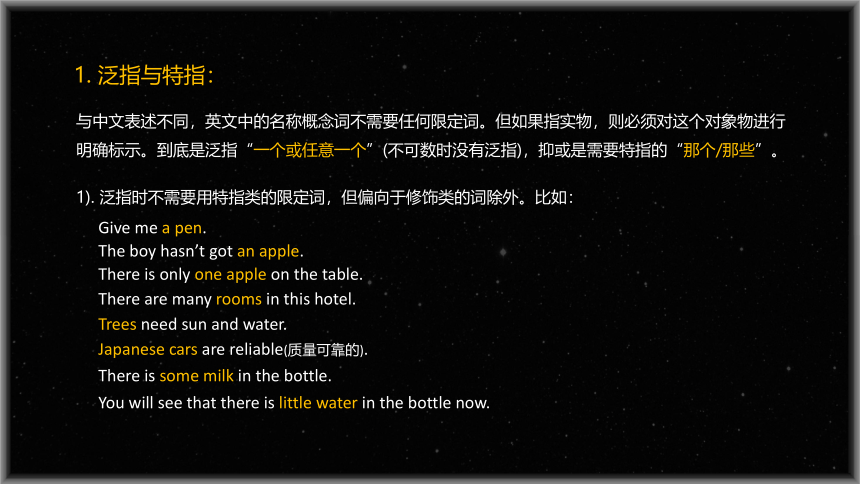

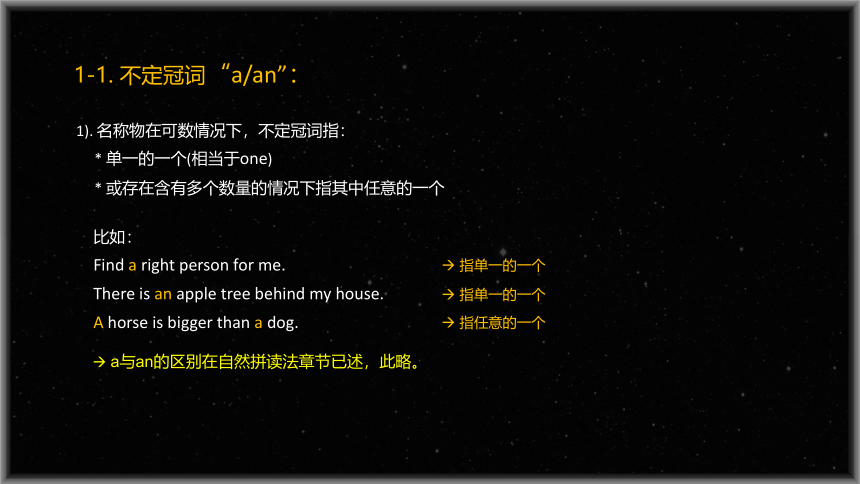
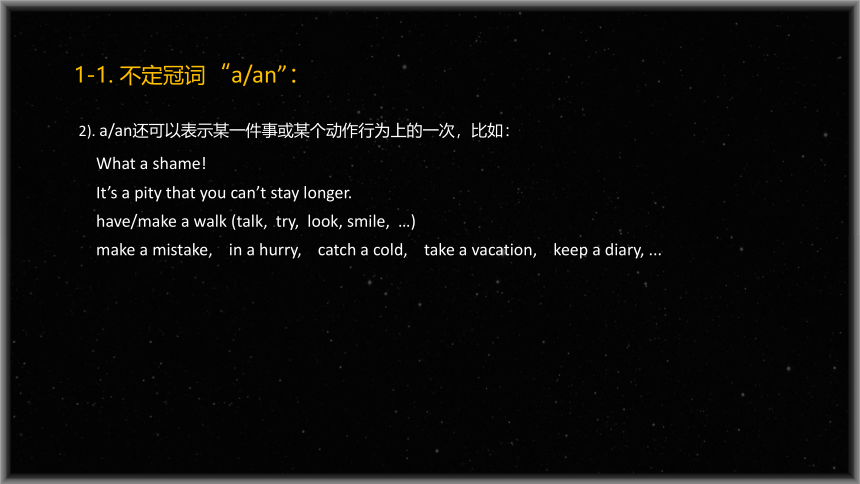
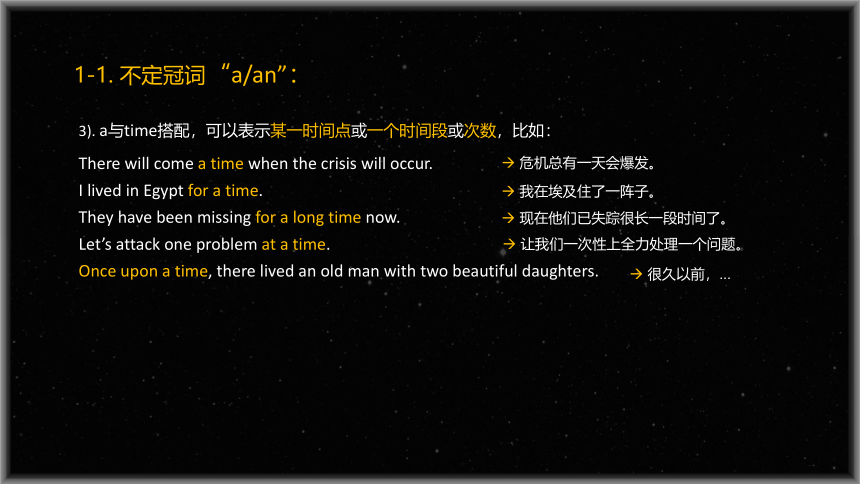
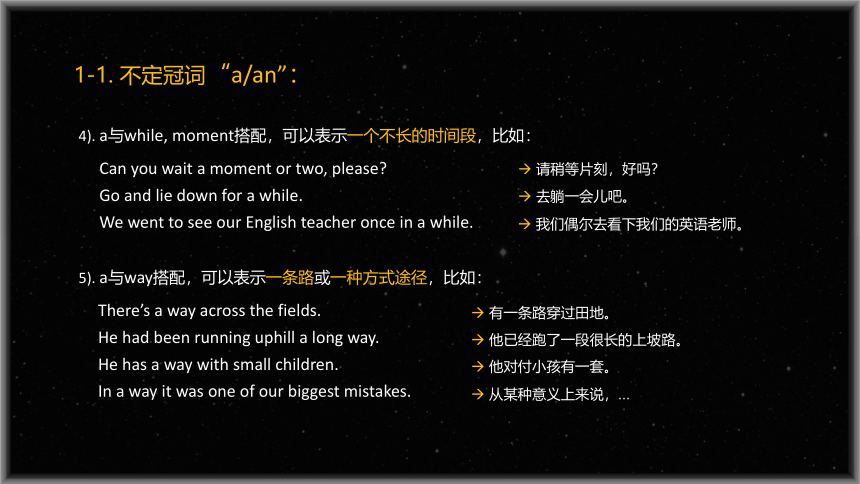
文档简介
(共19张PPT)
部分限定词的区别
Lesson 18:
授课人:曾老师
1. 泛指与特指:
与中文表述不同,英文中的名称概念词不需要任何限定词。但如果指实物,则必须对这个对象物进行明确标示。到底是泛指“一个或任意一个”(不可数时没有泛指),抑或是需要特指的“那个/那些”。
Give me a pen.
The boy hasn’t got an apple.
There is only one apple on the table.
There are many rooms in this hotel.
Trees need sun and water.
Japanese cars are reliable(质量可靠的).
There is some milk in the bottle.
You will see that there is little water in the bottle now.
1). 泛指时不需要用特指类的限定词,但偏向于修饰类的词除外。比如:
1. 泛指与特指:
The car under that tree is mine.
My bike is red.
This is Tom’s umbrella.
The oranges on the tree are still green.
Those cars are from Japan.
He went to visit Mary’s brothers.
The water in the bottle is too hot.
Those were the best years of my life.
2). 特指时需要用特指类的限定词对名称物进行限定。比如:
1-1. 不定冠词“a/an”:
1). 名称物在可数情况下,不定冠词指:
* 单一的一个(相当于one)
* 或存在含有多个数量的情况下指其中任意的一个
a与an的区别在自然拼读法章节已述,此略。
比如:
Find a right person for me.
There is an apple tree behind my house.
A horse is bigger than a dog.
指单一的一个
指单一的一个
指任意的一个
1-1. 不定冠词“a/an”:
2). a/an还可以表示某一件事或某个动作行为上的一次,比如:
What a shame!
It’s a pity that you can’t stay longer.
have/make a walk (talk, try, look, smile, …)
make a mistake, in a hurry, catch a cold, take a vacation, keep a diary, ...
1-1. 不定冠词“a/an”:
3). a与time搭配,可以表示某一时间点或一个时间段或次数,比如:
There will come a time when the crisis will occur.
I lived in Egypt for a time.
They have been missing for a long time now.
Let’s attack one problem at a time.
Once upon a time, there lived an old man with two beautiful daughters.
危机总有一天会爆发。
我在埃及住了一阵子。
现在他们已失踪很长一段时间了。
让我们一次性上全力处理一个问题。
很久以前,...
1-1. 不定冠词“a/an”:
4). a与while, moment搭配,可以表示一个不长的时间段,比如:
Can you wait a moment or two, please
Go and lie down for a while.
We went to see our English teacher once in a while.
5). a与way搭配,可以表示一条路或一种方式途径,比如:
There’s a way across the fields.
He had been running uphill a long way.
He has a way with small children.
In a way it was one of our biggest mistakes.
有一条路穿过田地。
他已经跑了一段很长的上坡路。
从某种意义上来说,...
他对付小孩有一套。
请稍等片刻,好吗?
去躺一会儿吧。
我们偶尔去看下我们的英语老师。
1-1. 不定冠词“a/an”:
6). 其它一些使用“a”的名称短语:
as a result, make a list, be in with a chance, ...
▲ 名称词在不可数的情况下,不能用泛指、特指或表数量、指示等的限定词进行修饰。
比如不能说:a water, a milk, this snow, that meat, these chicken, many leather, …
但有些特殊的词却可以,比如: a coffee (= a cup of coffee)
名称物不管可不可数,不管单数复数,都可以用the进行特指,这种特指存在三种情况:
* 指前文中有提及的对象物;
* 如果前文没有提及,则在其后有相关的限定短语来对“对象物”进行确定;
* 如果前后文都没有提及,则表示在表述情况所涉及的空间范围内,这个对象物是唯一的。
比如:
Tom bought a dog. The dog is white and black.
The car under that tree is mine.
She is sitting at the table.
Try to find the right person for me.
第一种特指:指前文中有提及的
第二种特指:后置限定的
第三种特指:当时的场景下,唯一的一个
1-2. 特定冠词“the”:
第三种特指:言指唯一的那一个
需要用限定词“the”等表示特指的情况很多。比如:
on the left
on the right
at the moment
at the age of ...
in the 1980s
all the time
in the end
for the first time
at the bottom of ...
at the top of ...
at the end of ...
at the door (village, bus stop, railway station, …)
on the (my...) way to school
by the way
at the same time
win the heart of sb.
get into the habit of
lay the table
play the piano (guitar, violin, ...)
What’s the matter with...
What’s the trouble with...
1-2. 特定冠词“the”:
2. “a(an)”与“one”的区别:
a(an):
因为仅用作限定词,所以它无法单独使用。
理论上它虽然表达了“单个/只/支/根/本…”
的意思,但话音内没有去强调数量这个概念。
我们来对比以下这二个例句:
Give me a pen.
I only need one pen. (two pens, three pens, …)
one:
作为数字限定词时,它明确强调其个数
为“1”。
相当于:给我支笔
我只需要一支笔
One couldn’t be working all the time without any break.
My mobile phone is too old, I want to buy a new one.
Which are the ones you really like
2. “a(an)”与“one”的区别:
“one”的用法相当广泛,这里就不一一说明了。
“one”作为数量为“单个的某人/事/物”的代称词时可以单独使用。
且可以用“a”或“the”来对它进行限定修饰。也同样有复数形式。比如:
3. “a(an)”与“any”的区别:
“any + 可数物单数”指任何一个(种/类等)。比如:
Give me a pen, please.
Any color is OK.
请给我支笔。
随便什么颜色都可以。
4. “a(an)”与“the”的区别:
当时环境下只有那一架钢琴
当时环境下不止一架钢琴,但没指哪一架
He is playing the piano.
He is playing a piano in the piano shop.
特指房间内唯一的张张床
病房里不止一张床,但没指哪一张
He is lying in the bed in his room.
He is lying in a bed in a hospital room.
泛指与泛指,看说话者的用意及当时的语境空间情况。例如:
传统语法书上说,西洋乐器类前面一定要用“the”,这个说法是错误的。
4. “a(an)”与“the”的区别:
去武汉的票,随便买一张
Go to buy me a ticket to Wuhan.
Go to buy me the ticket to Wuhan.
有些情况下,使用泛指与泛指都可以,但说话者的用意却不同。例如:
指定买去武汉的票,不要买错了
高考习题分析:
When every pupil in the school wears the uniform, nobody will have to worry about fashion(时尚). Everybody wears (57) the same style of clothes.
(2019年6月浙江高考卷)
the
The second reason is that people are living longer. A child born in US today has (63) very.
realistic chance of living beyond 100 and needs to plan accordingly.
(2020年1月浙江高考卷)
a
This style of farming lasted for quite a long time. Then, with (64) rise of science, change began. New methods meant fewer people worked in farming.
(2020年7月浙江高考卷)
the
It is called the Yellow River because its water carry earth, which gives the river its yellow-brown color. And when (65) river overflows, it leaves a yellow residue behind.
(安徽名校期末联考)
the
高考习题分析:
Almost all the coffee grown in the world today is one of two species, Arabica or Robusta, which might be wiped out in this way. There are other species existing only in Ethiopia, (57) .
country that climate change is hammering.
(21年4月金华十校高三模拟考)
a
However, Professor Arlene Astell from the University of Reading, believes smart speakers could prove to be (57) useful tool. This is because ......
(2021年浙江部分重高高三调研卷)
a
(浙江新高考名校联考卷)
Therefore, the village decided to turn to the tourist industry for (62) purpose of protecting the environment. In 2018, the village was included .....
the
“the third time”与“a third time”:
“the third time”: 强调排序
强调顺序上为第三次,意思为“他失败了二次,接下来他要尝试这第三次机会”。
“a third time”:不强调排序
表示“一而再,再而三”中的“三”。因为用的是不定冠词,所以尽管用了序数,但却并没有强调排序特指。
他可以又尝试第四次 “a fourth time”, 甚至第五次“a fifth time”。
试对比:
He has failed twice, but he’ll try the third time.
He has failed twice, but he’ll try a third time.
Give me the third pen.
Give me a third pen.
总数确定,现在把你手上的第三支笔给我
总数不确定,给了我二支笔后,现在要求又再给我一支
总次数确定,这是排到试第三次
总次数不确定,只是又再试一次
the:
从理论上表达“特指”的概念,或指听者应该知道的、或指前文中已提到的“这个(这些)或那个(那些)…”,但话音内却又没有从“指示、指向”的概念去强调这种限定。
5. “the”与“this”的区别:
我们来对比以下这几个例句:
Find the right person for me. Find this man for me.
Which do you want This one or that one
this:
作为限定词时,属于“指示类限定”,相当于用手指指着说的“这一个…”。
this只能修饰可数的名称物,且只能用来指单个的物体。
部分限定词的区别
Lesson 18:
授课人:曾老师
1. 泛指与特指:
与中文表述不同,英文中的名称概念词不需要任何限定词。但如果指实物,则必须对这个对象物进行明确标示。到底是泛指“一个或任意一个”(不可数时没有泛指),抑或是需要特指的“那个/那些”。
Give me a pen.
The boy hasn’t got an apple.
There is only one apple on the table.
There are many rooms in this hotel.
Trees need sun and water.
Japanese cars are reliable(质量可靠的).
There is some milk in the bottle.
You will see that there is little water in the bottle now.
1). 泛指时不需要用特指类的限定词,但偏向于修饰类的词除外。比如:
1. 泛指与特指:
The car under that tree is mine.
My bike is red.
This is Tom’s umbrella.
The oranges on the tree are still green.
Those cars are from Japan.
He went to visit Mary’s brothers.
The water in the bottle is too hot.
Those were the best years of my life.
2). 特指时需要用特指类的限定词对名称物进行限定。比如:
1-1. 不定冠词“a/an”:
1). 名称物在可数情况下,不定冠词指:
* 单一的一个(相当于one)
* 或存在含有多个数量的情况下指其中任意的一个
a与an的区别在自然拼读法章节已述,此略。
比如:
Find a right person for me.
There is an apple tree behind my house.
A horse is bigger than a dog.
指单一的一个
指单一的一个
指任意的一个
1-1. 不定冠词“a/an”:
2). a/an还可以表示某一件事或某个动作行为上的一次,比如:
What a shame!
It’s a pity that you can’t stay longer.
have/make a walk (talk, try, look, smile, …)
make a mistake, in a hurry, catch a cold, take a vacation, keep a diary, ...
1-1. 不定冠词“a/an”:
3). a与time搭配,可以表示某一时间点或一个时间段或次数,比如:
There will come a time when the crisis will occur.
I lived in Egypt for a time.
They have been missing for a long time now.
Let’s attack one problem at a time.
Once upon a time, there lived an old man with two beautiful daughters.
危机总有一天会爆发。
我在埃及住了一阵子。
现在他们已失踪很长一段时间了。
让我们一次性上全力处理一个问题。
很久以前,...
1-1. 不定冠词“a/an”:
4). a与while, moment搭配,可以表示一个不长的时间段,比如:
Can you wait a moment or two, please
Go and lie down for a while.
We went to see our English teacher once in a while.
5). a与way搭配,可以表示一条路或一种方式途径,比如:
There’s a way across the fields.
He had been running uphill a long way.
He has a way with small children.
In a way it was one of our biggest mistakes.
有一条路穿过田地。
他已经跑了一段很长的上坡路。
从某种意义上来说,...
他对付小孩有一套。
请稍等片刻,好吗?
去躺一会儿吧。
我们偶尔去看下我们的英语老师。
1-1. 不定冠词“a/an”:
6). 其它一些使用“a”的名称短语:
as a result, make a list, be in with a chance, ...
▲ 名称词在不可数的情况下,不能用泛指、特指或表数量、指示等的限定词进行修饰。
比如不能说:a water, a milk, this snow, that meat, these chicken, many leather, …
但有些特殊的词却可以,比如: a coffee (= a cup of coffee)
名称物不管可不可数,不管单数复数,都可以用the进行特指,这种特指存在三种情况:
* 指前文中有提及的对象物;
* 如果前文没有提及,则在其后有相关的限定短语来对“对象物”进行确定;
* 如果前后文都没有提及,则表示在表述情况所涉及的空间范围内,这个对象物是唯一的。
比如:
Tom bought a dog. The dog is white and black.
The car under that tree is mine.
She is sitting at the table.
Try to find the right person for me.
第一种特指:指前文中有提及的
第二种特指:后置限定的
第三种特指:当时的场景下,唯一的一个
1-2. 特定冠词“the”:
第三种特指:言指唯一的那一个
需要用限定词“the”等表示特指的情况很多。比如:
on the left
on the right
at the moment
at the age of ...
in the 1980s
all the time
in the end
for the first time
at the bottom of ...
at the top of ...
at the end of ...
at the door (village, bus stop, railway station, …)
on the (my...) way to school
by the way
at the same time
win the heart of sb.
get into the habit of
lay the table
play the piano (guitar, violin, ...)
What’s the matter with...
What’s the trouble with...
1-2. 特定冠词“the”:
2. “a(an)”与“one”的区别:
a(an):
因为仅用作限定词,所以它无法单独使用。
理论上它虽然表达了“单个/只/支/根/本…”
的意思,但话音内没有去强调数量这个概念。
我们来对比以下这二个例句:
Give me a pen.
I only need one pen. (two pens, three pens, …)
one:
作为数字限定词时,它明确强调其个数
为“1”。
相当于:给我支笔
我只需要一支笔
One couldn’t be working all the time without any break.
My mobile phone is too old, I want to buy a new one.
Which are the ones you really like
2. “a(an)”与“one”的区别:
“one”的用法相当广泛,这里就不一一说明了。
“one”作为数量为“单个的某人/事/物”的代称词时可以单独使用。
且可以用“a”或“the”来对它进行限定修饰。也同样有复数形式。比如:
3. “a(an)”与“any”的区别:
“any + 可数物单数”指任何一个(种/类等)。比如:
Give me a pen, please.
Any color is OK.
请给我支笔。
随便什么颜色都可以。
4. “a(an)”与“the”的区别:
当时环境下只有那一架钢琴
当时环境下不止一架钢琴,但没指哪一架
He is playing the piano.
He is playing a piano in the piano shop.
特指房间内唯一的张张床
病房里不止一张床,但没指哪一张
He is lying in the bed in his room.
He is lying in a bed in a hospital room.
泛指与泛指,看说话者的用意及当时的语境空间情况。例如:
传统语法书上说,西洋乐器类前面一定要用“the”,这个说法是错误的。
4. “a(an)”与“the”的区别:
去武汉的票,随便买一张
Go to buy me a ticket to Wuhan.
Go to buy me the ticket to Wuhan.
有些情况下,使用泛指与泛指都可以,但说话者的用意却不同。例如:
指定买去武汉的票,不要买错了
高考习题分析:
When every pupil in the school wears the uniform, nobody will have to worry about fashion(时尚). Everybody wears (57) the same style of clothes.
(2019年6月浙江高考卷)
the
The second reason is that people are living longer. A child born in US today has (63) very.
realistic chance of living beyond 100 and needs to plan accordingly.
(2020年1月浙江高考卷)
a
This style of farming lasted for quite a long time. Then, with (64) rise of science, change began. New methods meant fewer people worked in farming.
(2020年7月浙江高考卷)
the
It is called the Yellow River because its water carry earth, which gives the river its yellow-brown color. And when (65) river overflows, it leaves a yellow residue behind.
(安徽名校期末联考)
the
高考习题分析:
Almost all the coffee grown in the world today is one of two species, Arabica or Robusta, which might be wiped out in this way. There are other species existing only in Ethiopia, (57) .
country that climate change is hammering.
(21年4月金华十校高三模拟考)
a
However, Professor Arlene Astell from the University of Reading, believes smart speakers could prove to be (57) useful tool. This is because ......
(2021年浙江部分重高高三调研卷)
a
(浙江新高考名校联考卷)
Therefore, the village decided to turn to the tourist industry for (62) purpose of protecting the environment. In 2018, the village was included .....
the
“the third time”与“a third time”:
“the third time”: 强调排序
强调顺序上为第三次,意思为“他失败了二次,接下来他要尝试这第三次机会”。
“a third time”:不强调排序
表示“一而再,再而三”中的“三”。因为用的是不定冠词,所以尽管用了序数,但却并没有强调排序特指。
他可以又尝试第四次 “a fourth time”, 甚至第五次“a fifth time”。
试对比:
He has failed twice, but he’ll try the third time.
He has failed twice, but he’ll try a third time.
Give me the third pen.
Give me a third pen.
总数确定,现在把你手上的第三支笔给我
总数不确定,给了我二支笔后,现在要求又再给我一支
总次数确定,这是排到试第三次
总次数不确定,只是又再试一次
the:
从理论上表达“特指”的概念,或指听者应该知道的、或指前文中已提到的“这个(这些)或那个(那些)…”,但话音内却又没有从“指示、指向”的概念去强调这种限定。
5. “the”与“this”的区别:
我们来对比以下这几个例句:
Find the right person for me. Find this man for me.
Which do you want This one or that one
this:
作为限定词时,属于“指示类限定”,相当于用手指指着说的“这一个…”。
this只能修饰可数的名称物,且只能用来指单个的物体。
同课章节目录
- 词法
- 名词
- 动词和动词短语
- 动词语态
- 动词时态
- 助动词和情态动词
- 非谓语动词
- 冠词
- 代词
- 数词和量词
- 形容词副词及其比较等级
- 介词和介词短语
- 连词和感叹词
- 构词法
- 相似、相近词比较
- 句法
- 陈述句
- 一般疑问句和否定疑问句
- 特殊疑问句及选择疑问句
- 反意疑问句
- 存在句(There be句型)
- 宾语从句
- 定语从句
- 状语从句
- 主谓一致问题
- 简单句
- 并列句
- 复合句
- 主谓一致
- 主、表语从句
- 名词性从句
- 直接引语和间接引语
- 虚拟语气
- 感叹句
- 强调句
- 倒装句
- 祈使句
- 句子的成分
- 句子的分类
- 题型专区
- 单项选择部分
- 易错题
- 完形填空
- 阅读理解
- 词汇练习
- 听说训练
- 句型转换
- 补全对话
- 短文改错
- 翻译
- 书面表达
- 任务型阅读
- 语法填空
- 其他资料
